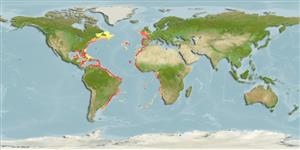Issue
This species is junior synonym of Synagrops japonicus according to Mediodia et al., 2024 (Ref. 132082:12).
Environment: milieu / climate zone / depth range / distribution range
Ecologia
marino batidemersale; distribuzione batimetrica 60 - 910 m (Ref. 7251), usually 107 - 179 m (Ref. 47377). Deep-water; 53°N - 41°S, 93°W - 14°E (Ref. 57282)
Eastern Atlantic: Guinea to Nigeria. Western Atlantic: Canada and Bermuda to Rio Grande do Sul including the Gulf of Mexico and the Caribbean. Western Pacific: New Caledonia (Ref. 86942).
Size / Peso / Age
Maturity: Lm ? range ? - ? cm
Max length : 23.0 cm SL maschio/sesso non determinato; (Ref. 47377); common length : 20.0 cm TL maschio/sesso non determinato; (Ref. 26999)
Spine dorsali (totale) : 10; Raggi dorsali molli (totale) : 9; Spine anali: 2; Raggi anali molli: 7.
Inhabits deep shelf and slope waters (Ref. 7251).
Life cycle and mating behavior
Maturità | Riproduzione | Deposizione | Uova | Fecundity | Larve
Mejía, L.S., A. Acero P., A. Roa and L. Saavedra, 2001. Review of the fishes of the genus Synagrops from the tropical Western Atlantic (Perciformes: Acropomatidae). Caribb. J. Sci. 37(3-4):202-209. (Ref. 43234)
IUCN Red List Status (Ref. 130435: Version 2024-2)
Threat to humans
Harmless
Human uses
Pesca: di nessun interesse
Strumenti
Special reports
Download XML
Fonti Internet
Estimates based on models
Preferred temperature (Ref.
123201): 10.1 - 23.2, mean 15 °C (based on 200 cells).
Phylogenetic diversity index (Ref.
82804): PD
50 = 0.7500 [Uniqueness, from 0.5 = low to 2.0 = high].
Bayesian length-weight: a=0.00912 (0.00581 - 0.01432), b=3.06 (2.93 - 3.19), in cm total length, based on LWR estimates for this species & (Sub)family-body (Ref.
93245).
Trophic level (Ref.
69278): 3.7 ±0.5 se; based on size and trophs of closest relatives
Fishing Vulnerability (Ref.
59153): Low vulnerability (18 of 100).
